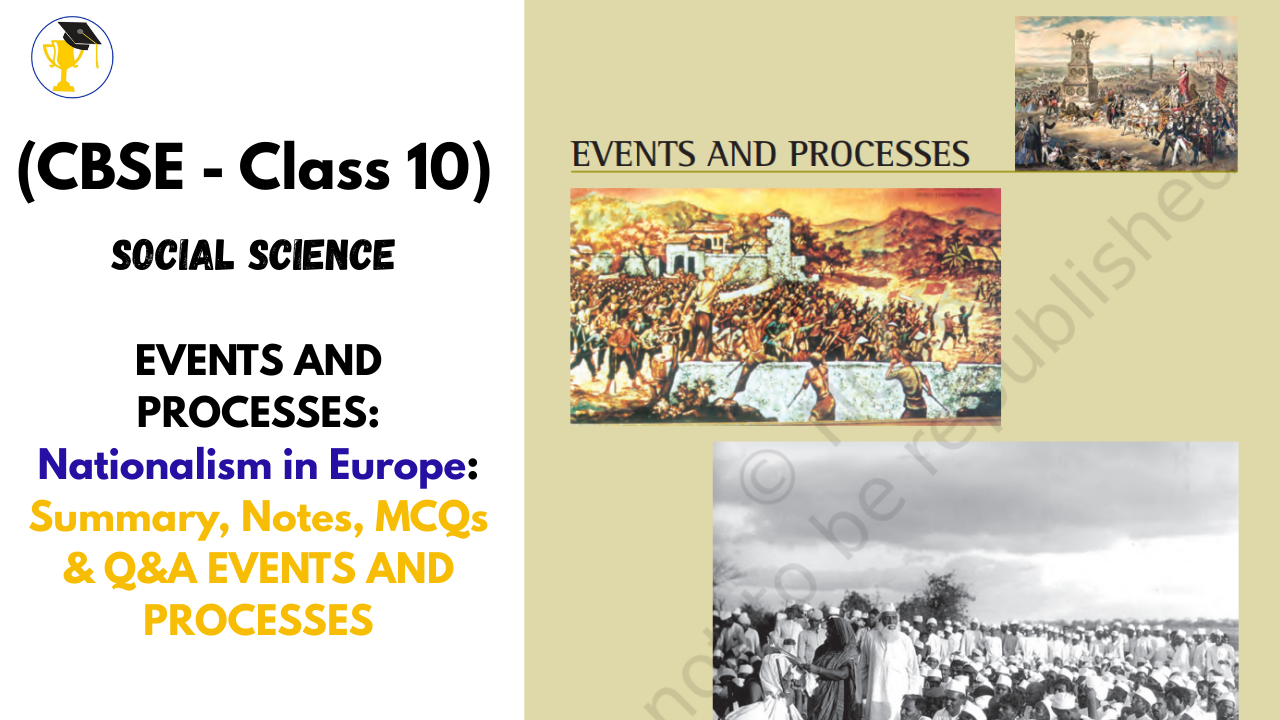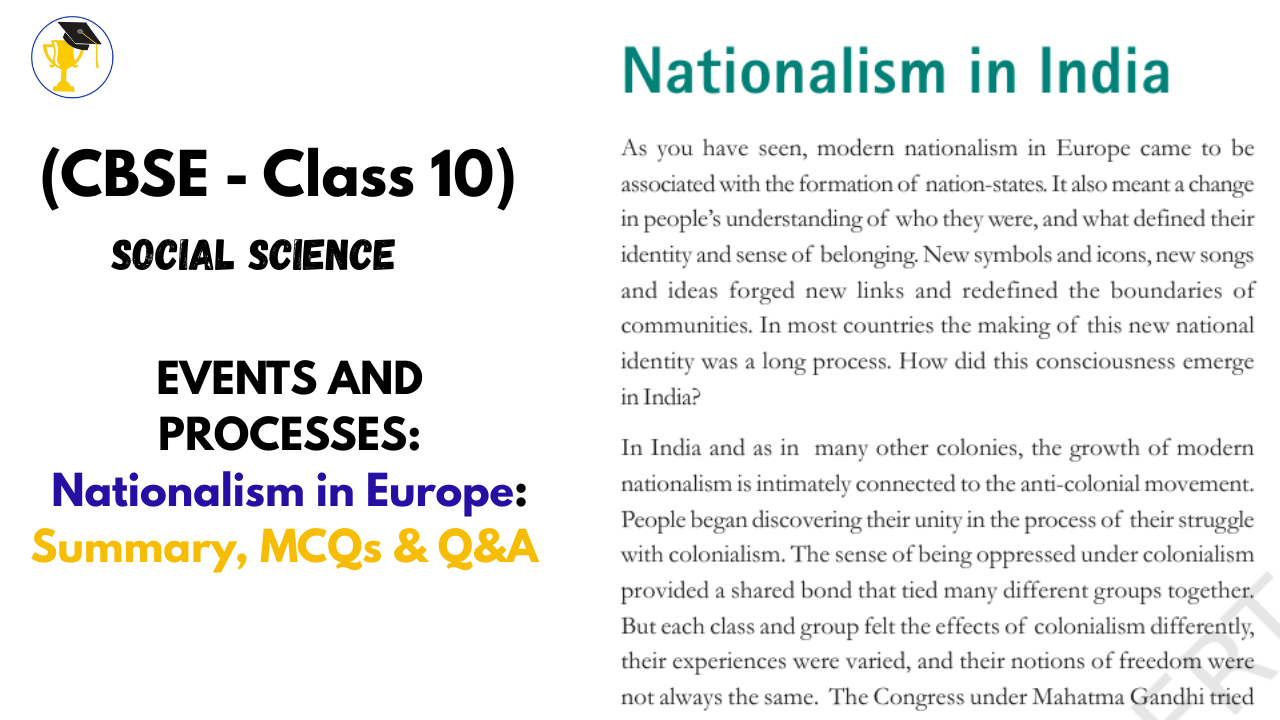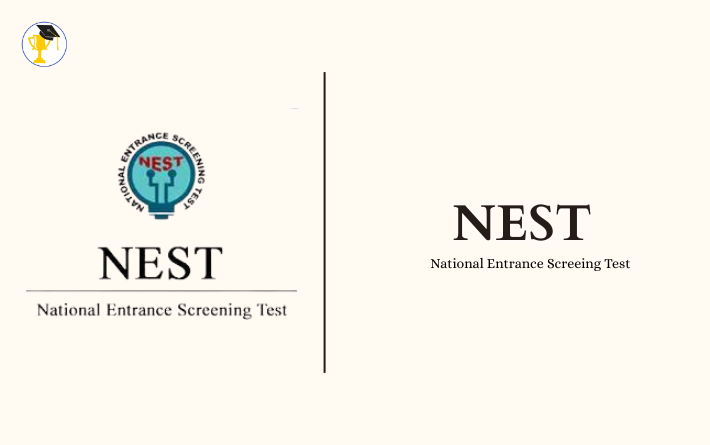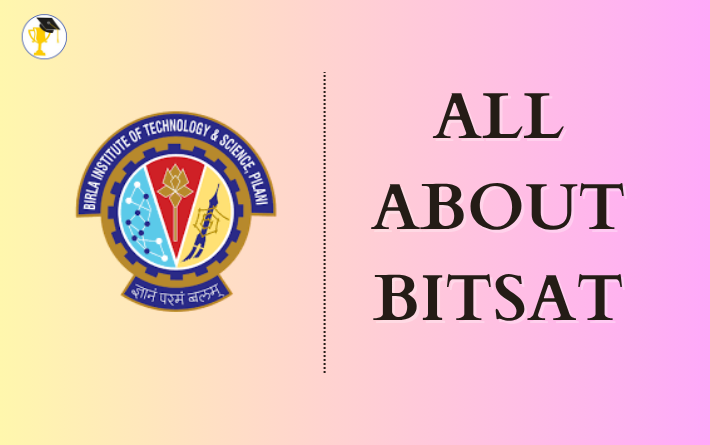
Class 10 Social Science – Nationalism in Europe (Ch.1) Complete Summary, MCQs & Q&A
CHAPTER SUMMARY — Nationalism in Europe
1. Sorrieu’s Utopian Vision (1848)
-
French artist Sorrieu visualised a world of democratic and social republics.
-
His painting shows people marching to the Statue of Liberty, symbolising nationalism and fraternity.
2. Rise of Nation-States
-
19th-century Europe moved from multi-national empires to nation-states.
-
Nation-state = people sharing common identity, history, and descent.
Section I — French Revolution and Nationalism
-
First clear expression of nationalism came with the French Revolution (1789).
-
Symbols: la patrie, le citoyen, tricolour flag, national anthem, uniform laws, common language.
-
Napoleon spread these ideas but also imposed authoritarian rule.
Section II — Making of Nationalism in Europe
Social Groups
-
Aristocracy dominated; peasants formed majority; new middle class emerged.
Liberalism
-
Emphasised freedom, equality before law, representative government.
-
But limited suffrage and no rights for women.
Zollverein (1834)
-
Prussian-led customs union → removed trade barriers → promoted economic nationalism.
Conservatism & Congress of Vienna (1815)
-
Restored monarchies; Bourbon dynasty reinstated; France contained by new states.
Revolutionaries & Secret Societies
-
Giuseppe Mazzini → Young Italy & Young Europe.
Section III — Age of Revolutions (1830–1848)
Greek War of Independence (1821–32)
-
Supported by artists, poets like Lord Byron.
Romanticism
-
Culture, folklore, volksgeist (Herder).
-
Grimm Brothers collected German folktales.
1848 Revolutions
-
Middle classes demanded constitutionalism, representative government.
-
Frankfurt Parliament failed; women excluded.
Section IV — Unification Movements
Germany (1871)
-
Led by Prussia; Bismarck’s “Blood and Iron”.
-
3 wars: Denmark, Austria, France → unification.
Italy (1861)
-
Led by Sardinia-Piedmont, King Victor Emmanuel II, Cavour.
-
Garibaldi’s Red Shirts unified the South.
Britain’s Unique Case
-
No revolution; English dominance over Scots, Irish created “United Kingdom of Great Britain” (1707).
Section V — Visualising the Nation
-
Female allegories: Marianne (France), Germania (Germany).
-
Symbols: broken chains, sword, oak leaves, rising sun.
Section VI — Nationalism & Imperialism
-
Balkans became the most explosive region.
-
Rivalry among powers → First World War (1914).
MCQs
1. Who prepared the 1848 print visualising democratic and social republics?
a) Lord Byron
b) Sorrieu
c) Delacroix
d) Herder
Answer: b)
2. La patrie and le citoyen were introduced during:
a) Greek War
b) Industrial Revolution
c) French Revolution
d) Congress of Vienna
Answer: c)
3. Zollverein was a customs union formed by:
a) Italy
b) France
c) Prussia
d) Austria
Answer: c)
4. Who founded Young Italy?
a) Cavour
b) Bismarck
c) Mazzini
d) Garibaldi
Answer: c)
5. Frankfurt Parliament met in:
a) Versailles
b) Vienna
c) Church of St Paul
d) Berlin Assembly
Answer: c)
6. Unification of Germany was completed in:
a) 1859
b) 1871
c) 1834
d) 1815
Answer: b)
7. Which allegory represented Germany?
a) Marianne
b) Liberty
c) Germania
d) Victoria
Answer: c)
8. Balkan region was mainly inhabited by:
a) Slavs
b) Germans
c) French
d) Italians
Answer: a)
9. Romanticism emphasised:
a) Reason
b) Science
c) Intuition & emotions
d) Industrial growth
Answer: c)
10. Garibaldi led the:
a) White Shirts
b) Red Shirts
c) Black Shirts
d) Blue Shirts
Answer: b)
Assertion–Reason
Q1
Assertion (A): The Balkans became a region of intense conflict.
Reason (R): Balkan states were jealous and each wanted more territory.
Answer: A and R both true, and R correctly explains A.
Q2
Assertion (A): Frankfurt Parliament failed.
Reason (R): Women were denied suffrage rights.
Answer: A true; R true but R is NOT the correct explanation.
CASE-BASED QUESTIONS
CASE 1 — (Based on Sorrieu’s painting, p.3–4)
Passage:In 1848, the French artist Frédéric Sorrieu prepared a series of four prints visualising his dream of a world made up of democratic and social republics. In his first print, people of different nations are shown marching in a long parade, offering homage to the Statue of Liberty. She holds the torch of Enlightenment in one hand and the Charter of the Rights of Man in the other. Artists used shattered pieces of the symbols of absolutist institutions lying on the ground, showing the destruction of monarchy. The scene reflects fraternity among nations and the rise of nationalism in Europe. At the front of the procession are the United States and Switzerland, which were already nation-states by 1848. Behind them are the people of Germany, Italy, and other European regions carrying their national flags.
Q1. Why does Sorrieu use shattered remains of absolutist symbols?
Answer: To show the end of monarchy and rise of democracy.
Q2. Which two nations were already nation-states in 1848?
Answer: The United States and Switzerland.
Q3. What does the torch in Liberty’s hand represent?
Answer: Enlightenment and freedom.
CASE 2 — (Based on Germania allegory, p.23–24)
In visual representations of the nation, artists in the nineteenth century began to use allegory, where an abstract idea is expressed through a person or a thing. In this way the nation was portrayed as a female figure. Germania became the allegory of the German nation. She was shown wearing a crown of oak leaves, as the German oak stood for heroism. Different artists depicted Germania with different symbols. In one hand she carried a sword, signifying readiness to fight; in the other, a shield with the German Eagle. Sometimes, she was shown holding the flag of the German Empire or wearing armour as a sign of strength and bravery.
Q1. What does the crown of oak leaves symbolise?
Answer: Heroism.
Q2. Why did artists use female allegories?
Answer: To personify the nation and give abstract ideas a human form.
Q3. What does the sword signify?
Answer: Readiness to fight for freedom.
VERY SHORT ANSWERS
Q.1 What is plebiscite?
Ans: Direct vote by people to accept or reject a proposal.
Q.2 Who was Cavour?
Ans: Prime Minister of Sardinia-Piedmont; architect of Italian unification.
Q.3 Who were Junkers?
Ans: Prussian large landowners.
Q.4 What is Zollverein?
Ans: Customs union formed in 1834 led by Prussia.
Q.5 What does volksgeist mean?
Ans: Spirit of the people (Herder’s idea).
Q.6 Who were the Red Shirts?
Ans: Garibaldi’s volunteers.
Q.7 Which year saw widespread revolutions?
Ans: 1848.
Q.8 Who painted “Massacre at Chios”?
Ans: Delacroix.
Q.9 Who personifies France?
Ans: Marianne.
Q.10 What caused tension in the Balkans?
Ans: Disintegration of the Ottoman Empire + rival nationalisms.
SHORT ANSWER QUESTIONS
1. Why did liberal nationalists oppose conservatives after 1815?
Ans: Conservatives restored monarchies, imposed censorship, opposed freedoms; liberals wanted constitutional governments and equality.
2. Explain the role of culture in strengthening nationalism.
Ans: Folk songs, poetry, art, folklore (Grimm Brothers), operas, language (Polish resistance) created shared cultural identity.
3. Why did the Frankfurt Parliament fail?
Ans: No support from monarchy; workers not included; women excluded; lack of unity among middle classes.
4. How did Napoleon contribute to nationalism?
Ans: Introduced Civil Code, abolished feudalism, improved transport, standardized laws—but imposed authoritarian rule.
5. Why was Britain’s nationalism different?
Ans: No revolution; English dominance; Act of Union 1707; suppression of Scottish/Irish identity.
6. Why did Greeks gain support during their independence struggle?
Ans: Admiration for ancient Greek civilization; support from European poets/artists; resentment towards Ottoman rule.
7. What led to the rise of the new middle class?
Ans: Industrialisation → growth of towns, markets, entrepreneurs, professionals.
LONG ANSWER QUESTIONS
Q.1 Trace the process of German unification.
The unification of Germany was carried out under the leadership of Prussia and its powerful Chief Minister Otto von Bismarck, who followed a policy of “Blood and Iron.” The early liberal attempt at unification through the Frankfurt Parliament (1848) failed due to lack of support from the monarchy and the aristocracy. After this, Prussia took charge of the unification process because of its strong army and efficient bureaucracy.
Bismarck planned three strategic wars to weaken rival powers and unite the German states under Prussian control:
-
Danish War (1864): Prussia and Austria defeated Denmark and gained control over Schleswig and Holstein.
-
Austro-Prussian War (1866): Prussia defeated Austria, ending Austrian influence in German affairs and forming the North German Confederation.
-
Franco-Prussian War (1870–71): Victory against France created a wave of nationalism and united the southern German states with Prussia.
Finally, in January 1871, the German Empire was proclaimed in the Hall of Mirrors at Versailles, with Kaiser William I as the German Emperor. Thus, Germany was unified through military strength, diplomacy, and rising nationalist sentiment.
Q. 2 Describe the steps taken by the French revolutionaries to create a sense of collective identity.
The French Revolution of 1789 introduced several measures to unite the French people and create a sense of collective national identity. The revolutionaries replaced the royal flag with the tricolour, which became the national symbol of France. They introduced the ideas of la patrie (the fatherland) and le citoyen (the citizen) to emphasise equality and a united community.
New national hymns, festivals, and oaths were created to inspire patriotism. The administrative system was centralised and a uniform set of laws was introduced for all citizens. Internal customs duties were abolished, and standardised weights and measures were adopted to promote economic unity.
The French language, especially as spoken in Paris, was promoted as the national language, while regional dialects were discouraged. The revolutionaries also believed it was France’s mission to spread the ideas of liberty and equality throughout Europe. Through these political, administrative, and cultural changes, the French successfully built a strong sense of national identity.
Q. 3 Explain the factors responsible for the rise of nationalism and tensions in the Balkans.
The Balkans became the most unstable region in Europe due to rising nationalism and competing political interests. The region was home to many ethnic groups like Serbs, Greeks, Bulgarians, Croats, and Romanians, collectively known as Slavs. These groups had once been independent but were brought under the control of the Ottoman Empire, which was weakening in the nineteenth century.
Inspired by romantic nationalism, these groups demanded freedom and independent nation-states based on shared history and culture. As the Ottoman Empire declined, different Balkan nationalities started revolts to assert their independence. Rivalry increased because each newly formed state wanted to expand its territory at the expense of the others.
The situation worsened due to the involvement of big European powers such as Russia, Austria-Hungary, Germany, and Britain, who competed to extend their influence in the region. This mixture of ethnic nationalism and international rivalry turned the Balkans into an area of intense conflict.
Ultimately, these tensions contributed directly to the outbreak of the First World War in 1914. Thus, the Balkans became the “powder keg of Europe” due to nationalism, territorial disputes, weakening imperial rule, and great power interference.
FOR FULL CHAPTER CLICK ON:
https://smartachievers.online/public/study_materials/jess301.pdf
Recent Posts
Class 10 Social Science – Nationalism in India (Chapter 2) Summary + MCQs + Q&A
Smartachivers
Nov 27,2025
Sant Longowal Institute of Engineering and technology, Admission 2026: Courses, Fees, Cutoffs, Placements & Ranking
Smartachivers
Nov 27,2025
Birla Institute of Technology, Mesra Admission 2026 – Courses, Fees, Cutoffs, Placements & Ranking
Smartachivers
Nov 27,2025
Class 10 Social Science – Nationalism in Europe (Ch.1) Complete Summary, MCQs & Q&A
Smartachivers
Nov 27,2025
Assam University (Silchar) — for the 2025-26 cycle: courses, fees, admission mode, cutoff/entrance basis, placements and ranking.
Smartachivers
Nov 26,2025
Complete 2025 Ranking of GFTI Colleges in India
Smartachivers
Nov 25,2025
UoH, Hyderabad, Admission 2026: Courses, Fees, Cutoffs, Placements & Ranking
Smartachivers
Nov 24,2025
Unlock Your Potential: Staying Disciplined in the Age of Smartphones
Smartachivers
Nov 21,2025
What to Do After 10th? A Complete Guide by Smart Achievers
Smartachivers
Nov 25,2025
NEET UG 2026 Biology: Preparation Tips to Score a Perfect 360 Marks
Smartachivers
Nov 19,2025
JEE Main 2026 Guide: Decoding Good Marks, Percentile & Rank
Smartachivers
Nov 19,2025
2026 CBSE Board Exams: Class 10 & 12 Theory and Practical Marks Breakup Now Available Online
Smartachivers
Nov 19,2025
ISI Admission Test 2026 – Exam Date, Eligibility, Syllabus, Pattern, Courses, Cut-Off & Preparation Guide
Smartachivers
Nov 18,2025
IISER Aptitude Test (IAT) 2026 – Exam Date, Eligibility, Syllabus, Pattern, Registration, Cut-Off & Preparation Guide
Smartachivers
Nov 18,2025
AIIMS Aptitude Test 2026 – NEET-Based Admission, Exam Pattern, Eligibility, Selection Process & Preparation Guide
Smartachivers
Nov 18,2025
CUET (UG) 2026 – Exam Date, Syllabus, Eligibility, Registration, Pattern, Cut-Off & Preparation Guide
Smartachivers
Nov 18,2025
NEST 2026 – Exam Date, Eligibility, Syllabus, Pattern, Registration & Preparation Guide
Smartachivers
Nov 18,2025
VITEEE 2026 – Exam Date, Eligibility, Syllabus, Fees, Registration, Cut-Off & Preparation Guide
Smartachivers
Nov 18,2025
BITSAT 2026 – Exam Date, Syllabus, Eligibility, Application, Pattern & Cut-Off
Smartachivers
Nov 18,2025
NEET-UG 2026-2027 – Exam Date, Eligibility, Syllabus, Registration & Preparation
Smartachivers
Nov 18,2025



















